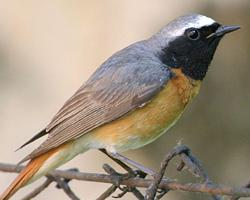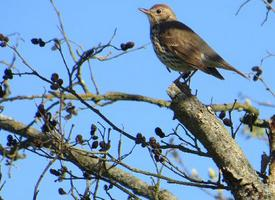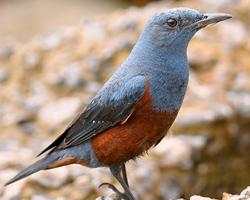
Greutăți și măsuri
| Lungime | 14 cm |
|---|---|
| Greutate | de la 12 la 19 g |
| Lungimea anvergurii aripilor | de la 20 la 24 cm |
Starea de conservare
| Amenințat |
Descrierea animalului
The Common Redstart (Phoenicurus phoenicurus) is a small and captivating passerine bird, a member of the thrush family, Turdidae, although its behavior and habits more closely resemble those of the Old World flycatchers. This species is highly regarded for its striking plumage and melodious song, making it a favorite among birdwatchers and nature enthusiasts.Adult male Common Redstarts exhibit a distinctive and vivid color palette. Their upper parts are a sleek grey, providing a soft contrast to the black face and throat. The most striking feature, however, is the chestnut-red tail and rump, from which the species derives its common name. The red is vivid and conspicuous, especially in flight or when the tail is fanned during display behaviors. Their underparts are a crisp white, leading to a stark and attractive contrast with the darker colors of their upper body and face. The wings are black with a noticeable white wing patch that adds to their striking appearance.
Female Common Redstarts, while not as brightly colored as males, possess their own subtle beauty. Their upper parts are a more muted brown, blending seamlessly into their natural surroundings, while their underparts are a paler, washed-out version of the males'. The red tail, though less vibrant than that of the males, still stands out and serves as a key identification feature.
Juvenile Redstarts share a resemblance with the females in terms of coloration but are distinguished by their scaly patterned appearance, a common trait among young birds.
The Common Redstart is a migratory bird, breeding across Europe and western Asia and wintering in Africa. Its preferred habitats are open deciduous forests, forest edges, and gardens, where it can be found perched conspicuously, often flicking its tail as it searches for insects. The diet of the Common Redstart primarily consists of insects and spiders, although it will also consume berries and seeds, especially during the colder months or while in its wintering grounds.
The nesting habits of the Common Redstart involve utilizing natural cavities in trees, cliffs, or even walls and buildings. The female is primarily responsible for constructing the nest, which is made up of grass, moss, and feathers, creating a soft and insulated environment for her eggs. The clutch usually consists of 5 to 6 eggs, which are incubated by the female alone. Both parents, however, share the responsibility of feeding the chicks once they hatch.
The song of the Common Redstart is a sweet and complex melody, consisting of a series of high-pitched notes that are delivered with enthusiasm, especially by males during the breeding season. Their song serves both to attract mates and to defend territories.
Despite facing threats from habitat loss and degradation, the Common Redstart is currently listed as Least Concern by the IUCN, thanks to its wide range and relatively stable population. However, continued conservation efforts are essential to ensure that this beautiful and charismatic bird remains a common sight across its range.
Animale similare
Fotografii noi cu animale
Top 10 animale
- Dolphin gull (Leucophaeus scoresbii)
- Diana monkey (Cercopithecus diana)
- Galápagos tortoise (Geochelone nigra complex)
- Moustached guenon (Cercopithecus cephus)
- Japanese spider crab (Macrocheira kaempferi)
- Colossal squid (Mesonychoteuthis hamiltoni)
- Stone loach (Barbatula barbatula)
- Fox tapeworm (Echinococcus multilocularis)
- Japanese macaque (Macaca fuscata)
- Barbary macaque (Macaca sylvanus)


